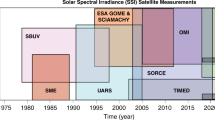Abstract
The photometric sunspot index (PSI) was developed to study the effects of sunspots on solar irradiance. It is calculated from the sunspot data published in theSolar-Geophysical Data catalogue. It has been shown that the formerPSI models overestimate the effect of dark sunspots on solar irradiance; furthermore results of direct sunspot photometry indicate that the contrast of spots depends on their area. An improvedPSI calculation is presented; it takes into account the area dependence of the contrast and calculates ’true’ daily means for each observation using the differential rotation of the spots. Moreover, the observations are screened for outliers which improves the homogeneity of the data set substantially, at least for the period after December 1981 when NOAA started to report data from a few instead of one to two stations. A detailed description of the method is provided. The correlation between the newly calculatedPSI and total solar irradiance is studied for different phases of the solar cycles 21 and 22 using bi-variate spectral analysis. The results can be used as a ‘calibration’ ofPSI in terms of gain, the factor by whichPSI has to be multiplied to yield the observed irradiance change. This factor changes with time from about 0.6 in 1980 to 1.1 in 1990. This unexpected result cannot be interpreted by a change of the contrast relative to the quiet Sun (as it is normally defined and determined by direct photometry) but rather as a change of the contrast between the spots and their surrounding as seen in total irradiance (integrated over the solar disk). This may partly be explained by a change in the ratio between the areas of the spots and the surrounding faculae.
Similar content being viewed by others
References
Allen, A.: 1973,Astrophysical Quantities, 3rd Ed., Athlone Press: London.
Beck, J.G., and Chapman, G.A.: 1993,Solar Phys., in press.
Brandt, P.N.: 1992,private communication.
Chapman, G.A., Cookson, A.C. and Dobias, J.J.: 1993,Astrophys.J., submitted.
Foukal, P.V. and Vernazza, J.: 1979,Astrophy.J. 234, 707.
Foukal, P.V. and Lean, J.: 1988,Astrophys.J. 328, 347.
Fröhlich, C. and Pap, J.: 1989,Astron. Astrophys. 220, 272.
Hoyt, D.V. and Eddy, J.A.: 1982,An Atlas of Variations in the Solar Constant Caused by Sunspot Blocking and Facular Emissions from 1874 to 1981, NCAR/TN194+STR, NCAR: Boulder, Co.
Hudson, H.S., Silva, S., Woodard, M. and Willson, R.C.: 1982,Solar Phys. 76, 211.
Hudson, H.S. and Willson, R.C.: 1982, in Physics of Sunspots, ed(s).,Cram, L. andThomas, J., Sacramento Peak Obs: Sunspot, 434.
Hudson, H.S.: 1989,private communication.
Livingston, W., Wallace, L. and White, O.R.: 1988,Science 240, 1765.
Maltby, P., Avrett, E.H., Carlsson, M., Kjeldseth-Moe, O., Kurucz, R.L., Loeser, R.: 1986,Astrophys.J. 306, 284.
Pap, J.M. and Fröhlich, C.: 1992, in Proc.Solar Electromagnetic Radiation Study for Solar Cycle 22, ed(s).,Donnelly, R.F., SEL NOAA ERL: Boulder, 62.
Steinegger, M., Brandt, P.N., Pap, J. and Schmidt, W.: 1990,Astrophys.Space Sci. 170, 127.
Tang, F.: 1981,Solar Phys. 69, 399.
Author information
Authors and Affiliations
Rights and permissions
About this article
Cite this article
Fröhlich, C., Pap, J.M. & Hudson, H.S. Improvement of the photometric sunspot index and changes of thedisk-integrated sunspot contrast with time. Sol Phys 152, 111–118 (1994). https://doi.org/10.1007/BF01473192
Received:
Revised:
Issue Date:
DOI: https://doi.org/10.1007/BF01473192




